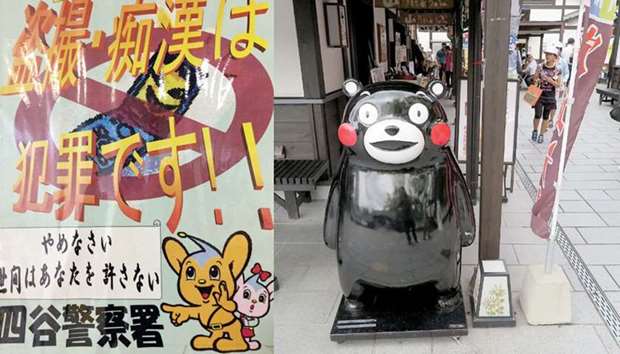A fluffy figure towers over passers-by on Tokyo’s famous Ginza shopping mile. With black button eyes and an enormous belly, he jiggles about, waving as he sways to and fro.
Nobody’s afraid of him, quite the opposite.
“Kawaii!” “Cute!” say two elderly Japanese ladies in delight, and have their photographs taken next to him.
Gumma-chan is the mascot of Tokyo’s neighbouring prefecture of Gumma, and is actually supposed to represent a horse.
Rather awkwardly, this enormous cuddly toy is waddling around in front of Gumma’s tourism office, trying to entice passers-by in.
It might look rather infantile to Westerners, but in Japan it’s nothing unusual.
Thousands of “yuru-kyara,” literally “laid-back characters,” can be found across Japan, the world’s third-largest economy.
Cities, provinces, countless businesses and organisations and even government ministries have their own mascots. There’s even a school for people whose job it is to put on these costumes and perform in them.
The Defence Ministry has the mascots Prince Pickles and his girlfriend Parsley.
Who would have thought to look at them, with their “delightful big eyes” and their “loveable smiles,” as the ministry describes them, that Japan is busy expanding its military in the face of the threat from North Korea?
And what about Pipo-kun, the mascot used by the police to show their soft side? Neither human nor animal, his name is made up of the first syllables of the English words “people” and “police.”
His big ears are said to help him hear the calls of citizens in need, and his big eyes observe “every corner of society,” Tokyo police write on their website.
For the past few years there has even been a national vote to find the most popular mascot, the so-called Yuru Kyara Grand Prix.
But mascots aren’t just cute, they’re also big business. For prefectures like Gumma, they’re a not-to-be-underestimated part of their image.
Experts like Hiroyuki Aihara, founder of an institute which belongs to the toy company Bandai and which focuses on mascots, says the Japanese love of them is connected to ancient beliefs and their countless deities.
The Japanese see deities “even in stones by the side of the road and in dead tree trunks,” he told the Asahi Shimbun newspaper. Consequently, mascots are beings in which “feelings and thoughts” are embodied.
Sadashige Aoki, professor of media and marketing at Hosei University, calls them “little deities.” Mascots give “comfort” to a society stressed out by everyday life, he says.
Kumamon, official representative of the prefecture of Kumamoto on Kyushu, the most south-westerly of Japan’s main islands, is the absolute mascot megastar.
He’s a funny, black rather clumsy-looking bear with bright red cheeks – the Japanese word Kuma, as well as being part of the name of the city and prefecture of Kumamoto, also means bear.
Kumamon has been a real money-spinner for his home prefecture and is featured on countless products including food, clothes, bags and even trains.
In fact, the mascot business is so enormous that two years ago the Finance Ministry announced a campaign to reduce the number of mascots and the unnecessary spending they encourage.
But in vain – the country is now swept up in a soon-to-be-launched competition for a new mascot for the 2020 Olympic Games in Tokyo. – DPA

Tokyo police hang posters featuring their big-eared mascot Pipo-kun. Right: The mascot of Japanese province Kumamoto can be seen in Tokyo promoting its region.


